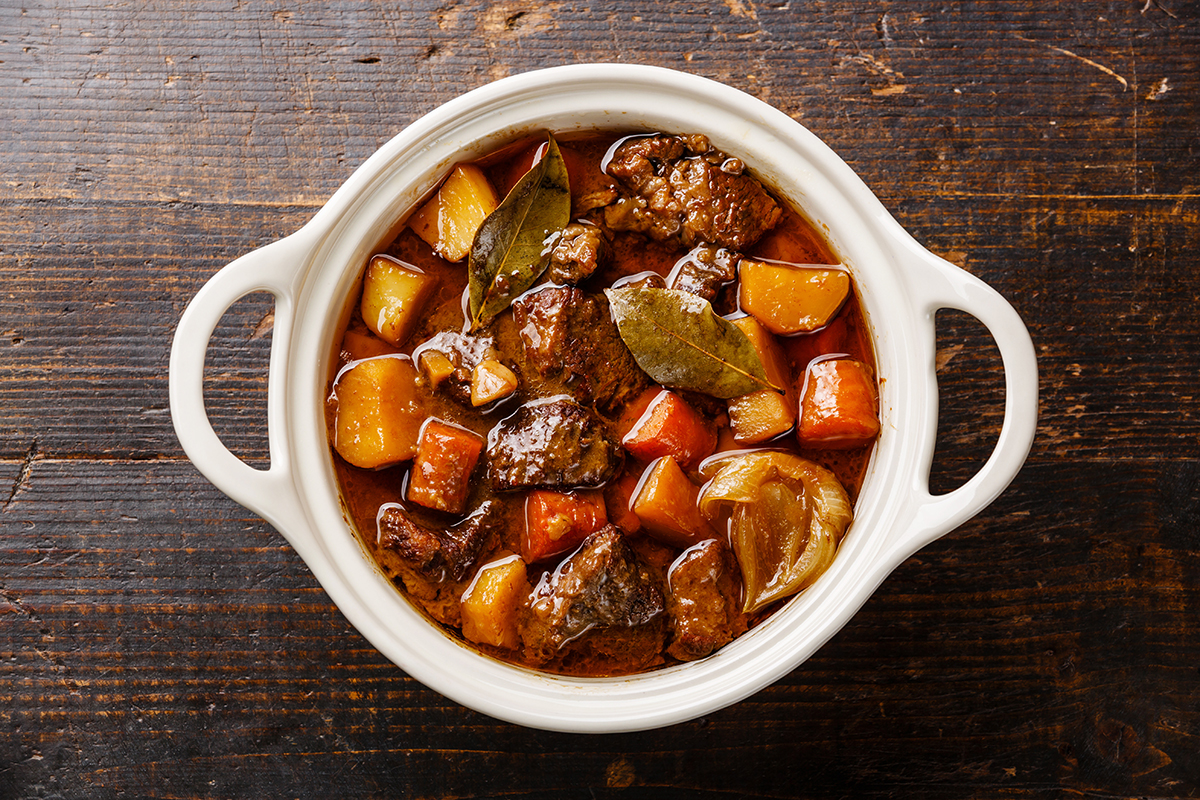Long nights, crisp days and the smell of wood smoke are indications a hot, substantial meal is very much in season. With that in mind I’d like to acknowledge the time-honoured stalwart of campfire and kitchen, Old Stew.
The gamut of meal offerings requiring a bowl – or at the least a deep plate with a prominent lip – is vast. Consomme at one end of the spectrum, hearty ragout at the other … the ‘wet dish’ genus is as ubiquitous and varied as the weather.
Not all spoonable delights, however, are created equal.
Should we be able to see through the soup? Clarity is often to be admired but I really want to get my teeth into something more substantial. For me, a robust fusion of meat, vegetables, herbs, stock, wine (or beer) cooked together for a couple of hours hits a mark that a chilled Iberian concoction of tomatoes never will. If you can’t be bothered to cook it, can you actually call it soup? Keep your lettuce and nettle, your French onion, and your cock-a-leekie! Give me a drum-roll for the casserole. A woo hoo for the stew. A hooray for the curry!
When it comes to variety, the alphabet of stews is as replete as a gourmands’s gut. From Bourguignon to Yahni – originating in every corner of our spherical homeworld; flavoured with ingredients steeped in historical significance – each stew speaks of the culture from which it was born.
Stews were big in the BCs. No wonder they taste so good today! We’re benefitting from 8,000 years of recipe development. From earliest known origins in Japan to the handy “cook-in-the-shell” turtle stew enjoyed by Amazonian tribes … (Could be a solution for ol’ Terry over at the Aquarium?) … our slow-cooked kai is delicious. And perfect for feeding a crowd. The 8,000-year-old story is punctuated with signposts as to how civilisations ate, hunted, farmed, gathered and lived.
History of the people by the people, ever since the folk of central Eurasia – in an early version of the sous vide – put cross-cut blade steak into the paunch of the yak, added water, then cooked it over a fire made of the same beast’s bones (recipe not supplied). And I thought that My Hello Food Bag was innovative!
It’s safe to assume the development of stews grew out of a need to avoid excessive chewing of dry, burnt meat during a time of poor dental hygiene practices. Think pulled pork, but even more problematic. Additionally, a large pot of steaming goodness was then, and is now, a great way to make a little go a long way.
The award for best supporting role in the story of stews goes to the invention of pottery cookware. I can easily imagine how much easier cooking a daube became rather than having to rely on tribal celebrity chef Heston Neanderthal’s ingenuity with animal parts to make a stew.
My genetic casserole is a mixture of Irish stew and Welsh cawl. Two of the many dishes that grew from cooking locally farmed and foraged ingredients way before it was fashionable.
Lamb neck and vegetables are the main ingredients in cawl. The seasonings: salt, pepper, and parsley, speak of an isolated culture the spice route completely bypassed.
Similarly neck chops, potatoes and onions are – so the purists maintain – the only three ingredients of Irish stew. I suggest that stews the world over are folk dishes and as such recipes vary from family to family, pantry to pantry, house to house, village to village, a bit like folk music, but easier to digest. Necessity is mother to many a recipe variation.
A good rule of thumb is: a cheap bit of meat, the vege you have to hand, herbs and or spices, liquid, and a slow, low cook.
Not everything works. Thirty-five years ago, my idea of a cheap way to feed the flat was a cauliflower and turkey thigh stew boiled for at least two hours. What a sulphuric affront to the senses!
Wiser – and undeterred by my youthful mistake – I now make a pretty good casserole.
I love this way of cooking. It’s a highlight of the cooler months for me. A wholesome, one-pot shared meal made more deliciously complex by today’s shopping lists. And so much easier to cook by the advent of cast iron. In 1940 a patent was taken out on the slow cooker, the Croc Pot, and with that, unattended cooking blew minds and filled the air with delicious aromas to come home to.
Whether you are a slow cooker or a Le Creuset pot user – or even a paunch-stuffing, bone-burning traditionalist – a one-pot, slurpable ambrosia is therapeutic in both cooking and in sharing. A simple pleasure to enjoy during the darker evenings.

